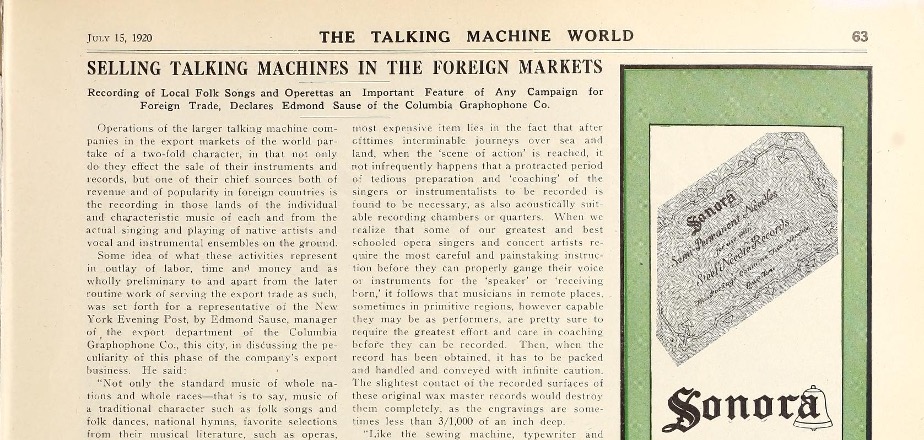
The 15 July 1920 edition of The Talking Machine World included an article on marketing records and phonographs by American companies in foreign countries, which consists primarily of a lengthy quote from Edmond Sause, the manager of the U.S.-based Columbia Graphophone Co.’s export department, and gives some details about the process of recording abroad, as well as the implications for U.S. companies.
Sause makes two major interesting points: First, that recording companies should try to record a wide variety of styles and genres, including both tradition and popular; and second, that the phonograph, at the time of his writing, was an invention unique to the United States, who therefore had a distinct advantage in the international talking machine market. The first of these suggests that major recording companies were not wholly focused on only recording “highbrow” classical or military music (although he does mention these), and that they were at least aware of the economic advantages of recording a wide variety of styles, even if they did not necessarily see any cultural value in them. Second, because the phonograph was invented and primarily developed in the United States, he views that country as the center of the phonograph trade, thereby turning all foreign countries into subordinate entities serving the economic interests of the U.S.
Although the article is very broad in its geographic scope and Latin America is only mentioned in passing, it still holds important implications for Latin American (recorded) music, as the region falls into a general category of a “foreign market,” or in other words, a resource to be used for the benefit of the United States.
“Like the sewing machine, typewriter and cash register, the talking machine can be said to be an American product. Its possibilities in foreign trade were appreciated practically from the beginning. While the industry was still struggling in home markets, progress was being made in developing foreign trade.”[1]
[1] “The talking machine world (July-Dec 1920).” Internet Archive. (2013). https://archive.org/details/talkingmachinew16bill/page/n87/mode/2up